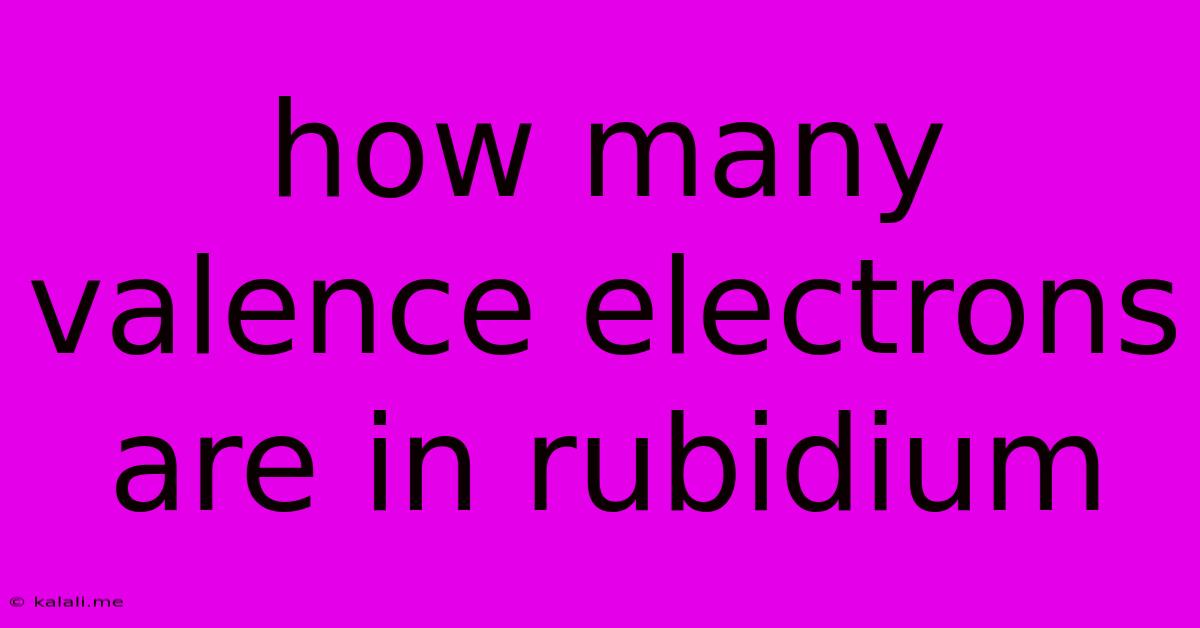How Many Valence Electrons Are In Rubidium
Kalali
Jun 13, 2025 · 2 min read

Table of Contents
How Many Valence Electrons Does Rubidium Have? Understanding Rubidium's Reactivity
Rubidium, a soft, silvery-white metal, is known for its high reactivity. This reactivity is directly tied to its number of valence electrons. Understanding valence electrons is key to predicting an element's chemical behavior. So, how many valence electrons does rubidium possess? The answer lies in its position on the periodic table and its electron configuration. This article will explore rubidium's electronic structure, explaining why it has the specific number of valence electrons it does and what that means for its chemical properties.
Understanding Valence Electrons
Valence electrons are the electrons located in the outermost shell of an atom. These electrons are the ones involved in chemical bonding, determining how an atom will interact with other atoms to form molecules or compounds. The number of valence electrons dictates an element's reactivity and the types of bonds it can form (ionic, covalent, metallic).
Rubidium's Position on the Periodic Table
Rubidium (Rb) is an alkali metal, found in Group 1 (or IA) of the periodic table. Elements within the same group share similar chemical properties due to having the same number of valence electrons. Group 1 elements are characterized by having one valence electron.
Rubidium's Electron Configuration
The electron configuration of rubidium is [Kr]5s¹. This configuration tells us the arrangement of electrons within its energy levels. The [Kr] represents the electron configuration of krypton, a noble gas, indicating a filled inner shell. The 5s¹ indicates that rubidium has one electron in its fifth energy level's s orbital. This single electron is its valence electron.
Why Only One Valence Electron?
The periodic table's structure is directly related to electron configurations. Each column represents a specific number of valence electrons. Since rubidium is in Group 1, it follows the pattern of having only one electron in its outermost shell. This single electron is relatively loosely held and readily participates in chemical reactions, leading to rubidium's high reactivity.
Consequences of Having One Valence Electron
Rubidium's single valence electron makes it highly reactive. It readily loses this electron to achieve a stable electron configuration, similar to the noble gas krypton. This electron loss results in the formation of a +1 ion (Rb⁺). This tendency to lose an electron explains why rubidium reacts vigorously with water, air, and other substances. It readily forms ionic compounds with nonmetals.
In Summary:
Rubidium has one valence electron. This single electron in its outermost shell is responsible for its high reactivity and its tendency to form +1 ions. Understanding its electron configuration and position on the periodic table clarifies why rubidium exhibits the properties it does. This knowledge is fundamental in chemistry, enabling predictions of chemical behavior and the formation of various compounds.
Latest Posts
Latest Posts
-
Emile Durkheim Classified Suicide Into Four Types The Types Were
Jun 14, 2025
-
Substance That Increases The Rate Of A Chemical Reaction
Jun 14, 2025
-
Difference Between Composite Materials And Alloys
Jun 14, 2025
-
Does University Of Minnesota Require Sat
Jun 14, 2025
-
Whats The Difference Between Shortage And Scarcity
Jun 14, 2025
Related Post
Thank you for visiting our website which covers about How Many Valence Electrons Are In Rubidium . We hope the information provided has been useful to you. Feel free to contact us if you have any questions or need further assistance. See you next time and don't miss to bookmark.